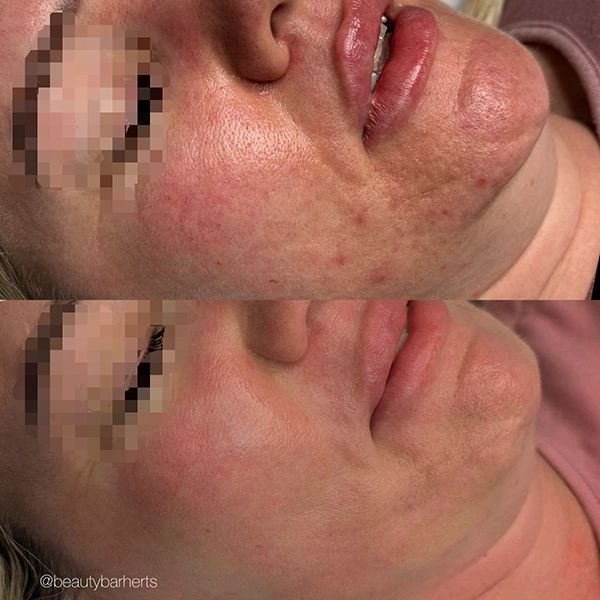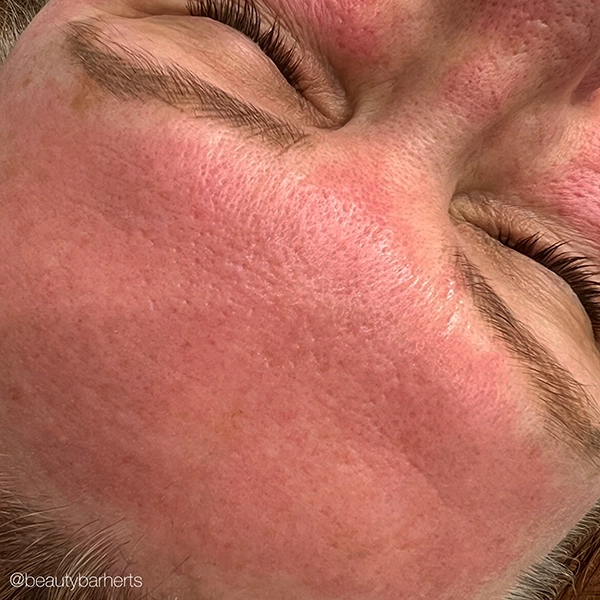Rosacea treatments in Hertfordshire
Rosacea skin treatments at Beauty Bar Hertfordshire
If you’re looking for effective treatments for rosacea, book your appointment at our beauty salon in Hertfordshire today. We will create a personalised plan for you and select the appropriate treatment based on your condition.
What is rosacea Hertfordshire
Rosacea is a chronic and progressive inflammatory skin condition. It is more common in women and usually affects the central area of the face. The symptoms include redness, telangiectasia (enlarged blood vessels), and papules or pustules (small bumps or pimples). In advanced stages, rosacea may lead to thicker irregular skin, known as rhinophyma, most seen in men, resulting in a “cauliflower nose.”
How do I know it’s rosacea?
Rosacea affects adults, between the ages of 30 and 60. It is a transient or persistent redness on the central part of the face and enlarged blood vessels.
Rosacea may be accompanied by a sensation of heat and burning.
Before rosacea develops, there is a pre-rosacea phase, showing as episodes of redness and a feeling of warmth on the face.


What do I need to know about rosacea?
What causes rosacea?
The exact cause is not very clear, but we know what triggers or worsens this condition.
- Genetics
- Hormonal changes
- Stress
- Temperature changes
- Tanning
- Alcohol and spicy food
- Perimenopause and menopause
At Beauty Bar in Hertfordshire, we offer personalised professional rosacea treatments. We can help you manage and reduce the symptoms of rosacea, and get clear and radiant skin.
Stages of rosacea
Stage 1 pre rosacea – occasional facial flushing or blushing in response to triggers such as emotions, spicy foods, or tanning. The redness is temporary without visible blood vessels. Symptoms are mild and easily dismissed as typical blushing.
Stage 2 vascular rosacea – redness becomes more noticeable. The central area of the face, cheeks, nose, and forehead, may look always red or flushed. Blood vessels become visible. Sensation of heat or warmth and mild skin sensitivity.
Stage 3 inflammatory rosacea – you develop papules and pustules. They may look like acne. It can cause discomfort, tenderness, itching or burning. The skin gets more sensitive, and the redness gets worse.
Stage 4 phymatous rosacea – in rare cases, rosacea progresses to phymatous rosacea, skin gets thicker, usually on the nose (rhinophyma). The skin gets bumpy, swollen, and the nose develops a bulbous and enlarged look. It may also be associated with enlarged oil glands and an irregular skin texture.
Not all people progress through all stages, and the severity can vary from person to person.
What makes rosacea worse?
Worsening redness, pimples, and enlarged blood vessels can be caused by improper skin care, tanning, hormonal changes, diet, alcohol, or stress. Long hot baths and showers, using sauna can also exacerbate it.
Using sunscreen and professional cosmetics are very important. Managing rosacea is a process that requires time and consistency. We help our clients choose the correct skincare and treatment plan.
Rosacea professional treatments Hertfordshire
Rosacea is a chronic and progressive. If left untreated it progresses through stages.
Rosacea treatments last 3-6 months, and the new enlarged blood vessels can show throughout the year. It is recommended to have a maintenance treatments every 4-6 months.
In adults, rosacea can also weaken the eyes and lead to conditions like eyelid inflammation, conjunctivitis, or even keratitis, which can result in vision loss, so it’s important to start the treatments as soon as possible.
Can rosacea be mistaken for other conditions?
Yes, sometimes it can be mistaken for other skin conditions like acne, lupus, allergic dermatitis or demodicosis.
How to prevent rosacea?
Avoid tanning and hide your face from the sun, wear strong sunscreen 50 or 100 SPF.
Protect your face from changing weather conditions. Avoid sugars, high carb food, spicy foods, alcohol (especially red wine), hot food and drinks.
Avoid taking hot baths and showers and sauna, follow daily proper skincare and receive professional skin treatments that will minimise skin inflammation.
What non invasive professional treatments can help with your rosacea?
Certain types of gentle, non irritating chemical peels can be beneficial for rosacea. Lactic acid or mandelic acid peel, will exfoliate the skin, reduce redness, and improve skin texture. Stronger chemical peels can worsen rosacea symptoms.
Some people with rosacea may benefit from treatments like mesotherapy and microneedling when paired with correct active ingredients to reduce skin inflammation.
We will assess your skin and suggest the best personalised professional treatment and skin care for you.
Book your rosacea treatment at Beauty Bar in Ware Hertfordshire
If you want to effectively treat rosacea, book your appointment at Beauty Bar in Ware Hertfordshire. We will create a treatment plan for you and choose the most suitable dermo cosmetics and treatments based on your skin condition.
At Beauty Bar, we offer treatments that combine advanced technology and high quality products to manage and reduce your symptoms. Whether you’re experiencing redness, visible blood vessels, or inflammation, we are here to help you get healthy skin.
Book your consultation or treatment today and take the first step towards clearer, healthier skin! We welcome clients from Hertfordshire and all nearby towns and villages including Ware, Welwyn Garden City, Stevenage, Cheshunt, Hatfield, Hertford, Hoddesdon, Broxbourne, Buntingford, Bengeo, Roysto and St Albans.
Rosacea treatments in Hertfordshire
Book your rosacea treatment at Beauty Bar Hertfordshire
Contact us today and take your first step towards better skin by booking your rosacea treatment.
